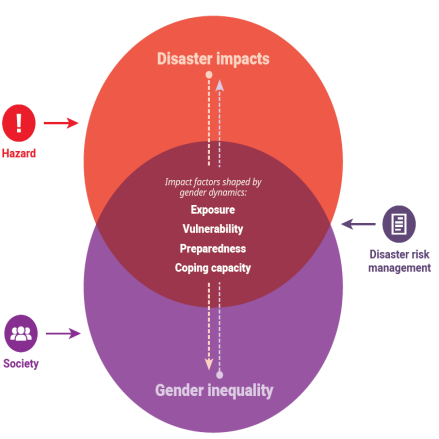Gender Dynamics of Disaster Risk and Resilience (original) (raw)
. This poses challenges for disaster risk management practitioners since information on affected population is often limited to aggregated numbers and seldom goes below the household level. However, it is also associated with opportunities. Because .
The Global Facility for Disaster Risk Reduction and Recovery (GFDRR) is committed to supporting gender inclusive approaches for better disaster risk management. A new World Bank Group report, Gender Dimensions of Disaster Risk and Resilience – Existing Evidence, financed by GFDRR, shows how . A global study finds that women’s mortality from disasters tends to be higher in relation to that of men in countries where women have lower socioeconomic status.

(A conceptual framework for considering gender dynamics and disaster impacts adapted from World Bank 2012 and Hallegatte et al. 2017)
- Disaster impacts (orange circle) depend on hazard type and intensity, exposure (who and what is at risk of being affected), levels of vulnerability (susceptibility to damage), preparedness and coping capacity.
- Gender inequality (purple circle) arises from the expected roles of men and women in a society, which influence socioeconomic status, level of agency, and the way men and women prepare for, react to, are impacted by, and recover from, disasters.
- In the overlay (maroon area) between gender inequality and disaster impacts are the factors that drive disaster impacts and are influenced by gender dynamics. This is where gender differentiated impacts happen. Gender-differentiated impacts of disasters can exacerbate gender inequality, which in turn can worsen resilience to future disasters.
- That is why disaster risk management policies and interventions should operate in the overlay area, using the tools available for mitigating disaster impacts and strengthening resilience to close the gender gap in outcomes. This means .
Based on the framework, the report looks at the role of gender in disaster impacts more broadly ─ from health and education to employment and assets to gender-based violence and child marriage. The report goes a step further than previous studies looking at gender and disasters by covering the role of gender in resilience ─ including disaster preparedness and coping capacity.
Some of the key takeaways are:
- . Biological factors also play a role.
- Although women are in a disadvantage position in society at large, this does not always translate into worse disaster outcomes for women and girls. Men account for 70% of flood-related deaths in Europe and the United States primarily due to overrepresentation of men in rescue professions.
- Women in particular face barriers to access information and resources needed to adequately prepare, respond and cope to a disaster ─ including access to early warning and safe shelter, as well as to bank accounts to protect savings from disasters and stable income.
- , as well as positive spillover effects on women’s position in the community.
- Disaster recoveries are opportunities to build back in a way that breaks down the constraints faced by women.
The report identifies crucial policy actions that can be taken before, during and after a disaster to mitigate gender-differentiated impacts of disasters.
Finally, the report lays out key analytical and operational priorities to enhance this agenda, including:
- Understand what does and does not work for different population groups by investing more in rigorous impact evaluations and assessments for designing projects.
- Make resources and guidance available to facilitate gender gap assessments in disaster risk management at the country and project level.
- Promote sex and age disaggregated data collection in post-disaster assessments and other disaster related data collection.
- Leverage new data and technologies—such as mobility data—to explore topics, previously understudied, including gendered evacuation patterns and behaviors.
For more information, access full report here.